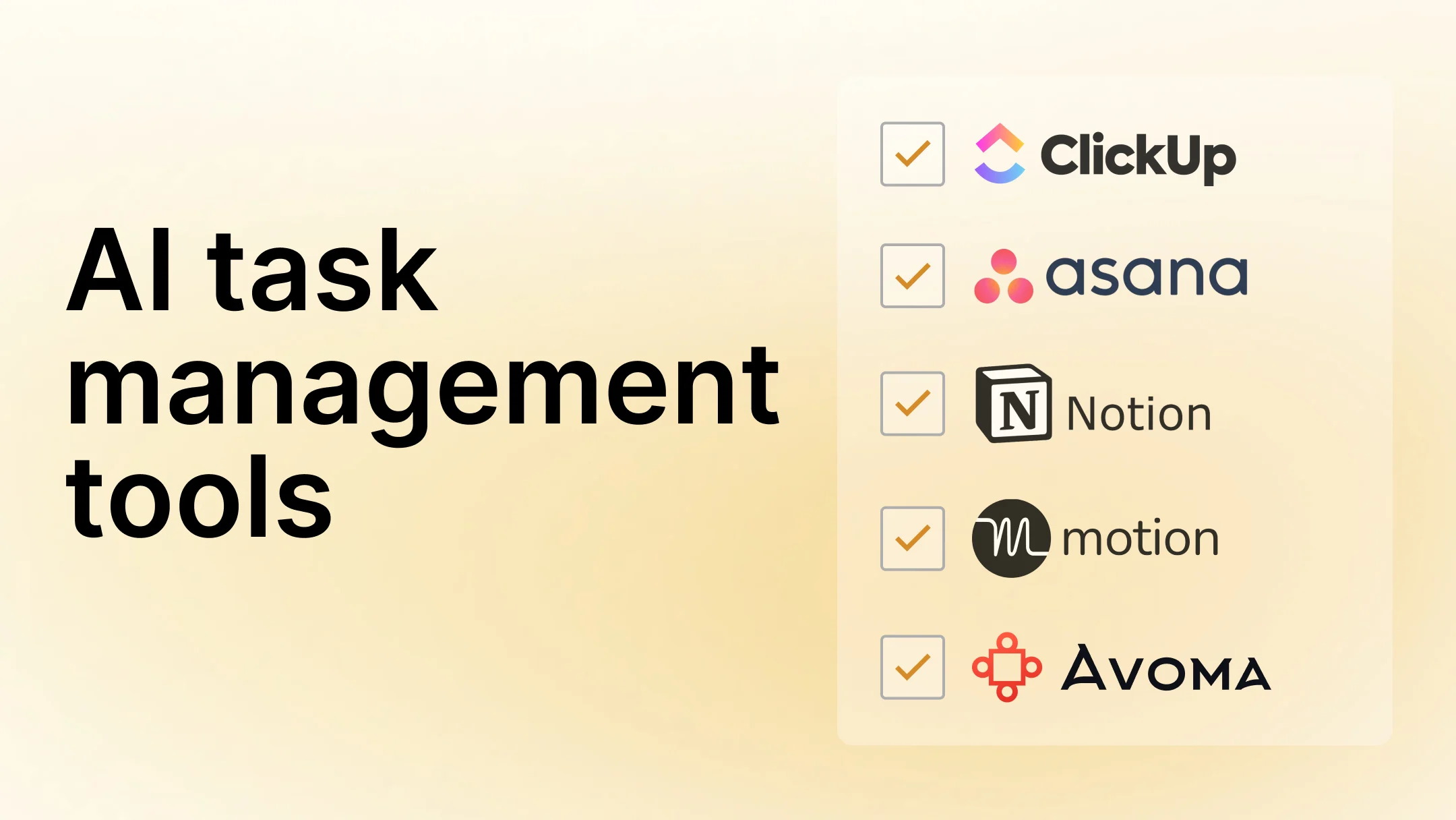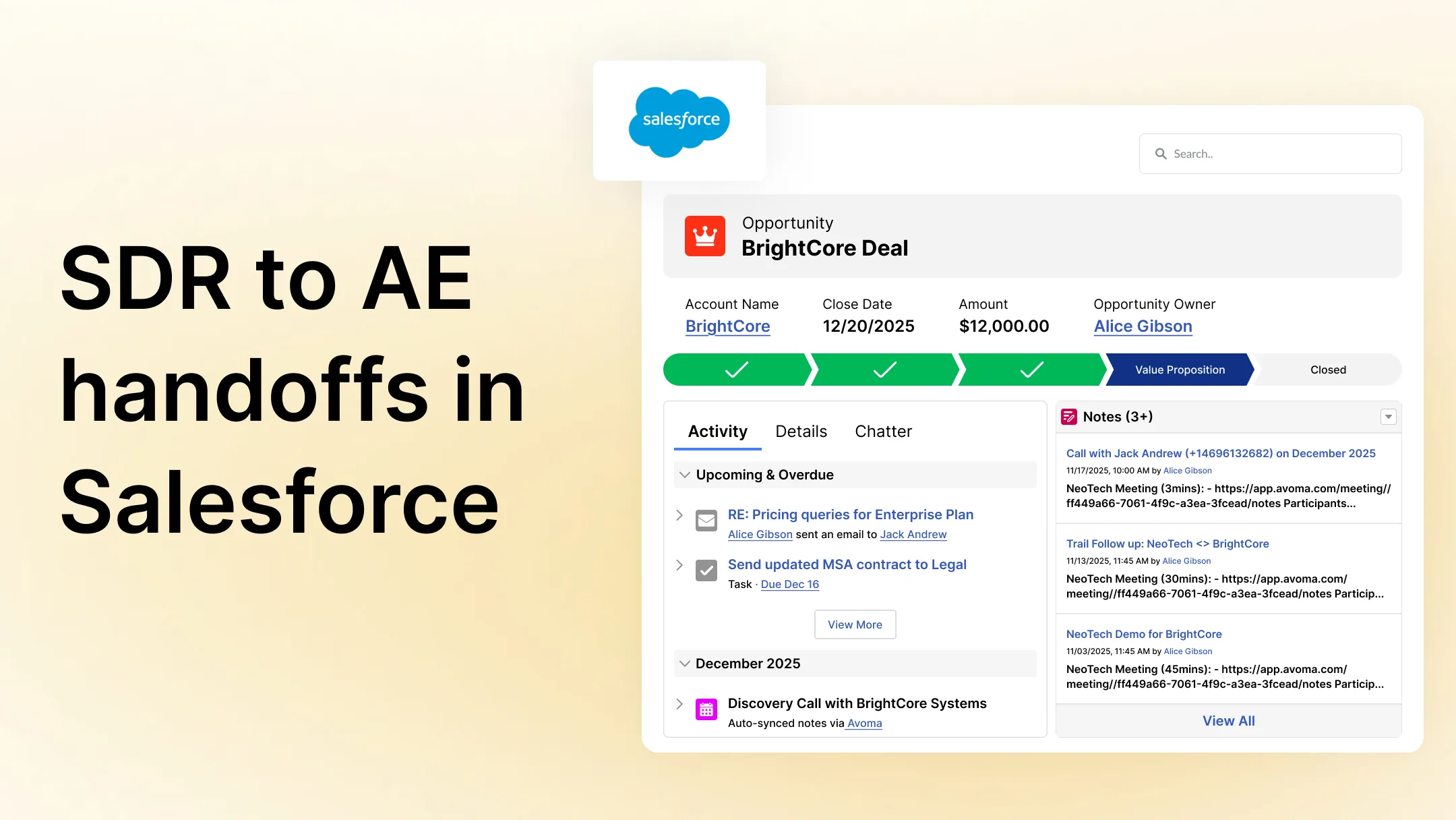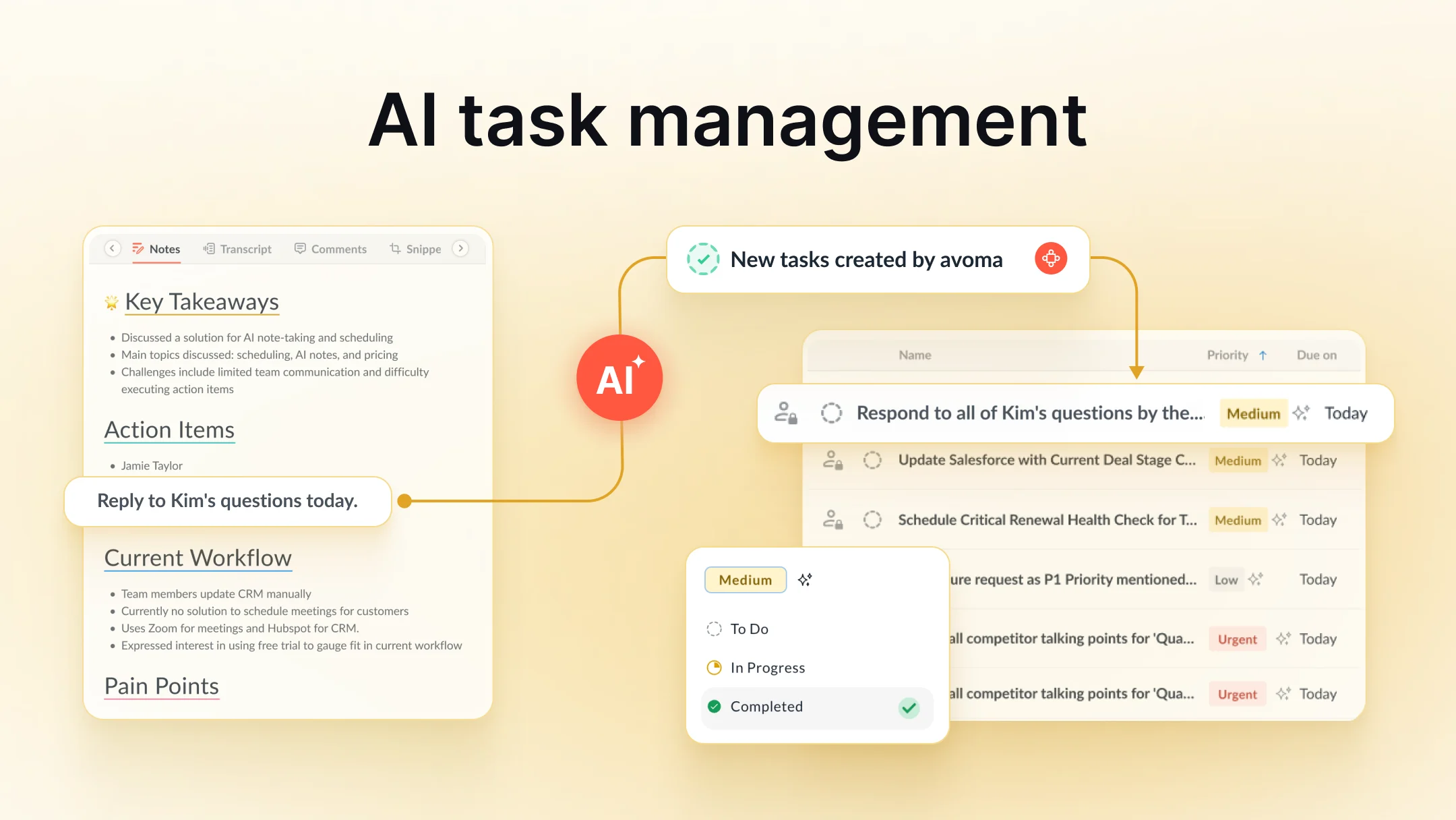Proven sales closing techniques to get more deals across the finish line
Table of Contents:
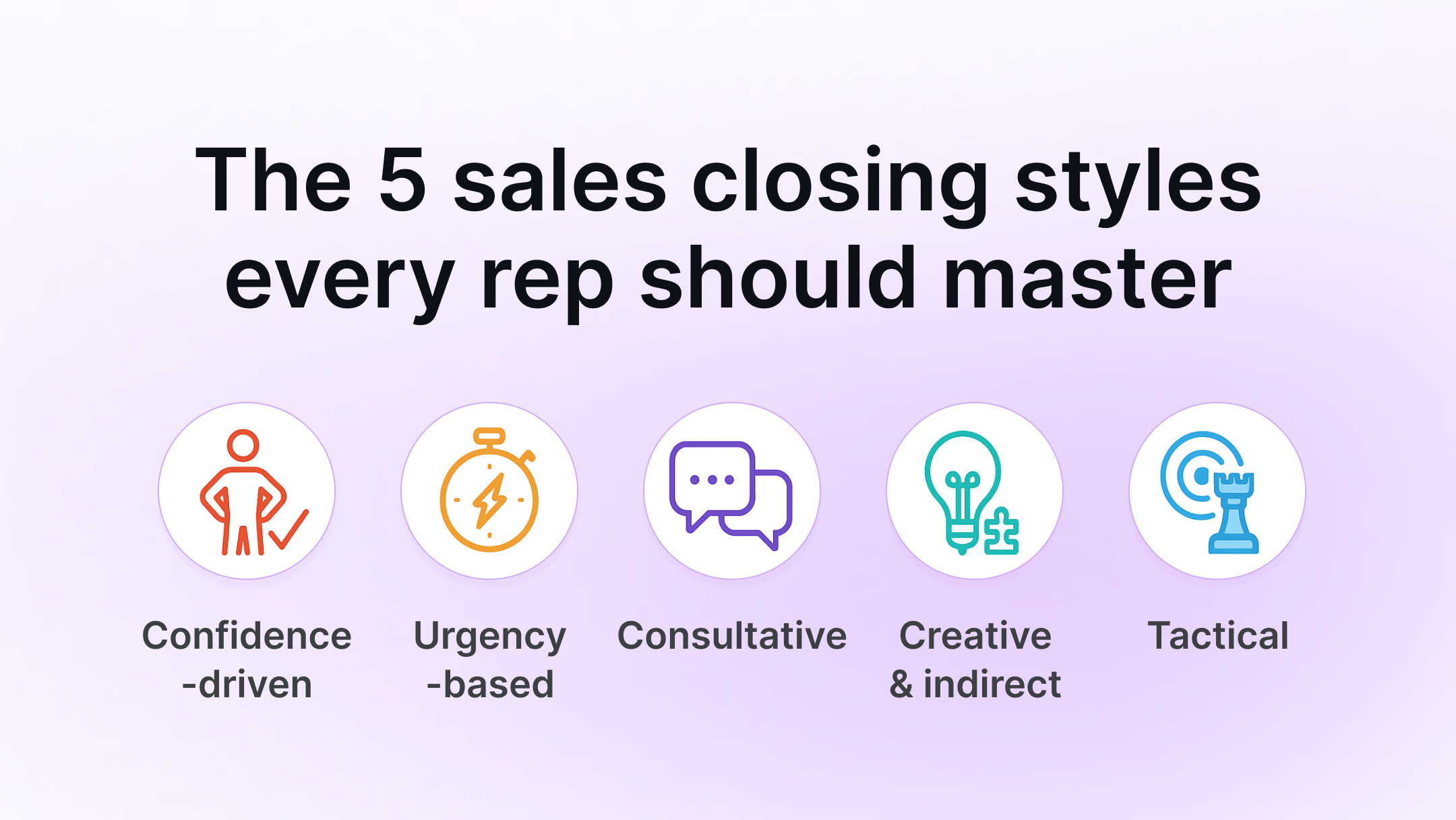
Sales closing techniques aren’t just for the final ask. They start in discovery, build through the demo, and show up in every moment that moves the deal forward. And with close rates sitting at just 12% in B2B SaaS and only slightly higher for agencies, financial advisors, and software development (15–16%), every interaction matters.
Top reps don’t close at the end; they close in layers. They read the room. They adjust mid-call. They know when to lean in and when to shut up.
In this guide, you’ll get 23 field-tested techniques with examples, mapped to real buyer mindsets and deal scenarios built to create momentum early and close clean when it matters most.
Why closing techniques work (and why you need more than one)
At Avoma, we’ve analyzed thousands of sales calls, and one pattern jumps out. The best reps don’t close the same way every time. Top closers switch up their style nearly 3x more often than average.
Because closing isn’t about dropping a polished line, it’s about pressure-matching. The cautious ops lead won’t respond to the same close that works on an urgency-driven CRO. Different people, different triggers, different moments.
That’s the real edge: not just knowing the script, but knowing when to change it.
Here’s how we break the sales closing techniques down
- Confidence-driven closes: when your buyer wants to be led
- Urgency-based closes: when momentum is fading
- Consultative closes: when buyers need to convince themselves
- Creative and indirect closes: when trust is fragile
- Tactical closes: when you need a specific move
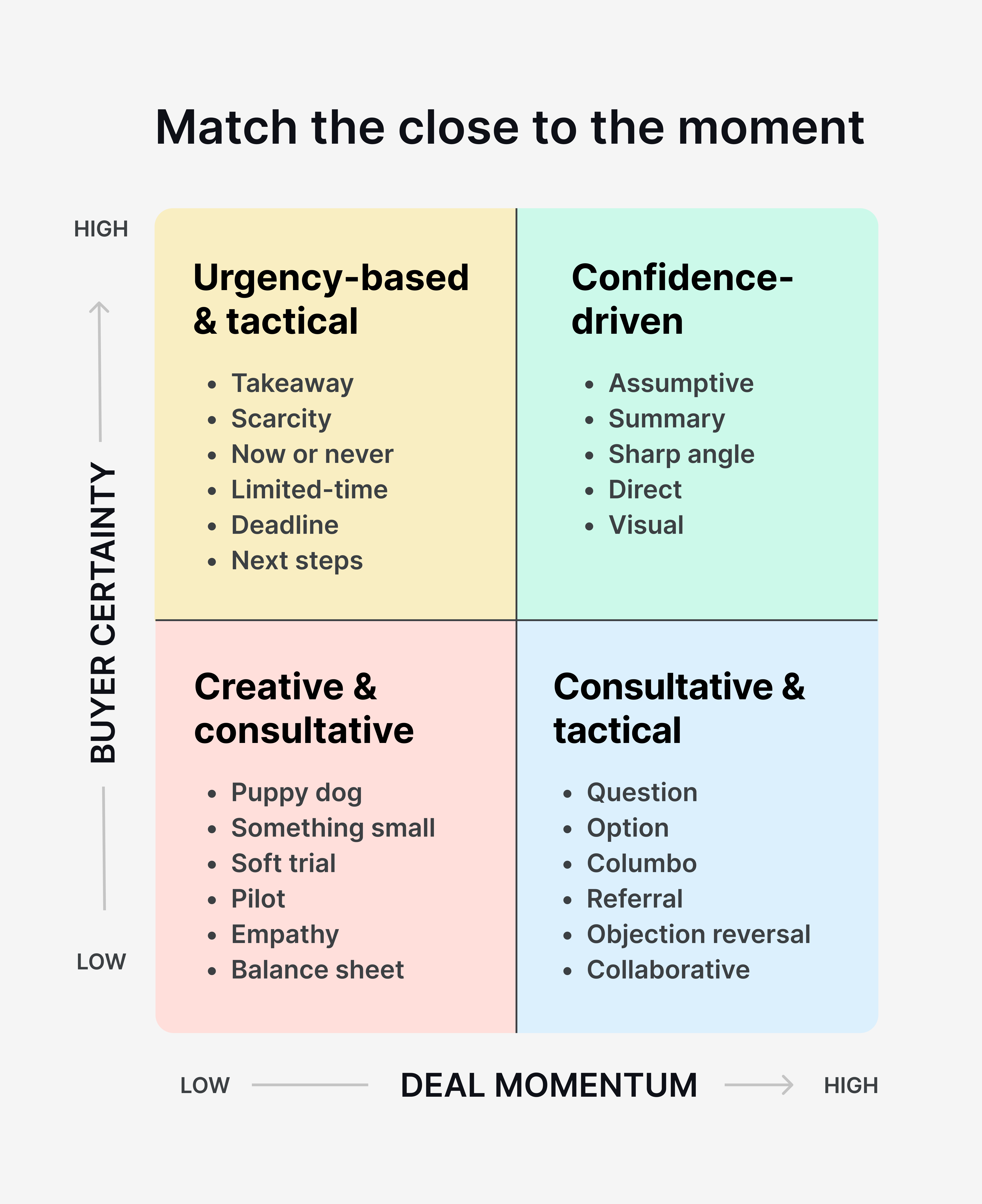
1. Confidence-driven closes
Some buyers don’t need coaxing. They need a closer who leads. These are the moments where confidence matters more than charm: when the buyer is ready, and your job is to make the decision easy to say yes to.
Use these when the buyer is leaning in, the solution is clear, and you need to guide them across the line.
Assumptive close
This works when the buyer has given strong buying signals and no major objections remain. Don’t ask for the close, behave like it’s already happened.
Example
"Sounds like next week’s start date still works, right?"
Summary close
Use this to recap what they’re agreeing to, so they can validate the decision out loud. It feels collaborative but still directs the deal forward.
Example
"So just to confirm, you're getting [X], [Y], and [Z], and we’re aligned on the rollout plan. Anything else before we lock this in?"
Sharp angle close
Flip a buyer request into a close by tying your yes to theirs. This works best when they’re negotiating and you sense they’re close to committing.
Example
"If we can include that, are you ready to sign today?"
Direct close
Keep it simple and direct. No fluff, no push. Use it when the moment’s right and you’ve earned it.
Example
"Are you ready to move forward?”
Visual close
Show the buyer what “yes” looks like. A visual next step, like a timeline, kickoff plan, or contract preview, helps reduce hesitation and build momentum.
Example
"Here’s what next week could look like. Want to walk through it together?"
2. Urgency-based closes
Many deals die because reps wait too long. These closes are designed to create forward motion, not by pressuring, but by spotlighting what’s at stake.
Use these when the deal is real but stalling, when momentum dips, or when hesitation starts creeping in.
Now or never close
Use this when a real incentive or window is about to close. It works because buyers hate missing out, especially when the value is clear.
Example
"If we get this wrapped by Friday, we can still include the legacy discount. Want to go ahead and lock that in?"
Takeaway close
Step back from the deal to create space and pressure. This close works because people are more motivated by the fear of losing a good opportunity than the promise of gaining one. It puts the ball back in their court, signals that you’re not chasing, and often surfaces the real blocker that’s been hiding behind silence.
Example
"We’re holding this open on our side, but I don’t want to assume it’s still active if priorities have shifted. Should we close the loop for now?"
Limited-time close
Use when there’s a time-bound trigger like end-of-quarter pricing, campaign start, fiscal budget, etc. It reframes urgency around an external event.
Example
"Just a heads up, if we don’t finalize by Thursday, this pricing tier rolls over. Do you want me to hold it?"
Deadline close
Set a firm timeline for the decision without being aggressive. Useful for aligning internal stakeholders or syncing with upcoming initiatives.
Example
"To hit your August launch date, we’d need to kick off by next week. Does that timeline still work on your end?"
Scarcity close
Point to real limitations like seat caps, implementation slots, and beta access. It only works if the scarcity is legitimate and relevant.
Example
“We only have two onboarding slots left for this month. Should I pencil one in for you?"
3. Consultative closes
Some buyers don’t respond well to push. They need space to think, compare, and process. These closes work by guiding them to their conclusion, without pressure, but with purpose.
Use these when the buyer is hesitant, analytical, or needs help seeing the logic—or when the real stakeholder isn’t even in the room.
As executive coach Bill Berman puts it,
The close becomes natural when you're solving their boss's problem through them. They become your internal champion because you're making them look good upstairs, not just solving their immediate pain point.
His advice before any closing attempt?
Ask: What does success look like to the person who has to approve this decision? Then mirror that language exactly.
Question close
Instead of pushing, ask a pointed question that helps them arrive at the decision.
Helps when the buyer seems engaged but stalls at the finish line. Ideal when the blocker isn’t obvious yet.
Example
"What’s holding you back from moving forward today?"
Empathy close
Name the emotion they’re feeling to build trust and lower resistance.
Works when the buyer seems overwhelmed, uncertain, or emotionally blocked, even if the logic checks out.
Example
"Feels like there’s still some hesitation. Want to talk through it together?"
Balance sheet close
Help them list pros and cons so they can weigh the decision out loud.
Best for rational thinkers who need to process things clearly and want structure before deciding.
Example
"Mind if we sketch out what you’re gaining by moving forward vs what you’d be giving up by waiting?"
Option close
Frame the decision as a set of choices to give them control and momentum.
Great for buyers who hesitate under pressure but move when they feel ownership.
Example
"We can start with a full rollout, or begin with a smaller pilot. Which feels better on your side?"
Columbo close
Play a little dumb, then slip in a subtle ask. Disarming but effective with high-ego or skeptical buyers.
Use this when the buyer guards control or sees traditional closing as a threat.
Example
"Remind me, didn’t you say legal usually needs 1–2 weeks? If that’s the case, and you’re still aiming for a Q3 start, wouldn’t we need to send the docs soon? Totally could be off, just double-checking here."
4. Creative and indirect closes
Not every deal calls for a hard close. Sometimes the best move is to lower the stakes, shift the frame, or build trust through action. These closes work when you think pressure doesn't win, and patience wins.
These closes work when pressure doesn’t win, and patience does.
Shawn Hayes, founder of Share Web Design, has used this model for 15+ years:
I co-design the solution with the client before I even send a proposal. It already feels like we’re solving things together.
His approach speaks to the power of the “something small” or pilot close get the buyer involved early, frame the sale as a collaboration, and create a natural path to momentum instead of forcing commitment.
Puppy dog close
Let them try it first. This works when the product proves itself fast, and the risk of saying yes is low.
Example
"Why don’t you test it with your team this week and see if it sticks?"
Something small close
Offer a tiny next step to keep the motion going without asking for a full yes.Use this when the buyer is engaged but hesitant to commit. Maybe they need internal buy-in or just aren’t ready for a bigger decision. Keeps momentum without pressure.
Example
"How about we start with just the integration review? No commitment yet, just alignment."
Soft trial close
Ask a closing question without making it feel final. Great for gauging readiness.Use this when the deal is close, but you’re not sure how ready they are to sign. It’s a temperature check. You’ll either surface last-minute resistance or get a soft yes; you can firm up.
Example
"If everything looks good by Thursday, would you be open to signing then?"
Pilot close
Frame the close as a low-risk experiment. Ideal for conservative buyers or complex orgs. Use this when risk is the blocker. It can be budget, implementation, or stakeholder fear. It makes the decision feel reversible and removes perceived downside.
Example
"Let’s run a 30-day pilot and see how it performs. If it works, we scale; if not, no problem."
5. Tactical closes
Tactical closes are precision plays designed for the moments when the deal gets murky, hits resistance, or needs a strategic nudge. Tactical closes help you adjust without forcing it.
Use these when the deal is real but stuck, when objections linger, or when you need to reframe the next step.
Objection reversal close
This works by validating the buyer’s concern, then reframing it as a reason to move forward. You’re not deflecting, you’re redirecting based on real insight.
Helps when the objection is real but rooted in perception, not fact. Great in late-stage pricing or feature pushback.
Example
“Totally get it. Going with a familiar vendor feels safer. But based on what you shared, the real goal is faster ramp and better adoption. The bigger risk is sticking with what’s already slowing you down. Why not run a quick trial alongside your current process? Worst case, nothing changes. Best case, you cut onboarding time by 30–40%.”
Referral close
Buyers trust buyers more than sellers. This close offers social proof in the form of access, not just a case study.
Works when credibility is in question or your champion needs ammo for internal alignment.
Example
"If it helps, I can connect you with a similar team that rolled this out last quarter. Want me to set that up?"
Next steps close
Instead of asking for the decision, ask for the next clear action. This reduces friction and builds quiet commitment.
Ideal when legal, procurement, or other internal processes are slowing momentum.
Example
"Would it make sense to align on next steps and loop in legal on your side?"
Collaborative close
Make the close a mutual solution, not a seller-led ask. It shows partnership and creates buy-in.
Use it when the buyer wants to feel ownership, or when final alignment depends on a few loose ends.
Example
"Let’s work through the final few pieces together and make sure this feels right on both sides."
How to pick the right close
Here’s the truth most people miss: the best close isn’t your favorite one. It’s the one that fits the moment.
That means stepping back and asking three quick questions before you go for it:
- What’s your buyer’s personality type?
Are they assertive or amiable? Analytical or expressive? Are they ready to move forward or still circling? - Where are you in the deal?
Is this your first closing motion or the final stretch? Are they still evaluating or already verbally committed? - What’s the real blocker?
Is it trust? Timing? Price? Internal alignment? The close should help move through that, not just get to yes.
Here’s a simple cheat sheet to help you match close type to deal dynamics:
- Use confidence-driven closes when the buyer wants clarity and leadership
- Use urgency-based closes when hesitation is about time or momentum
- Use consultative closes when the buyer needs to convince themselves
- Use creative and indirect closes when trust is fragile or pressure backfires
- Use tactical closes when you’re stuck, stalled, or need to reframe
Not sure which one fits? Ask Avoma.
Ask Avoma is an AI-powered assistant that analyzes your actual deal data, call transcripts, buyer behavior, objections, and engagement to recommend the most relevant close for that moment. Use this prompt to get tailored recommendations for any call or deal.
Prompt to analyze which closes to use for a particular deal
Based on the full context of this deal, including all call transcripts, sentiment analysis, buyer behavior, objections, and engagement, which one of the following 23 closing techniques is most appropriate to use right now?
Please return:
The recommended close
The category it belongs to
A brief reason why it fits this specific deal
A sample close line tailored to this situation
Choose from these 21 closes:
Confidence-driven:
Assumptive, Summary, Sharp Angle, Direct, Visual
Urgency-based:
Now or Never, Takeaway, Limited-Time, Deadline, Scarcity
Consultative:
Question, Empathy, Balance Sheet, Option, Columbo
Creative/Indirect:
Puppy Dog, Something Small, Soft Trial, Pilot
Tactical:
Objection Reversal, Referral, Next Steps, Collaborative
Return only 1 recommended close with justification and example.
Want to know what has worked before? Ask Avoma.
Use this AI prompt to spot the most effective closing techniques across all your past closed-won deals, broken down by buyer persona, stage in the pipeline, and deal size.
Use this to coach your team with data and spot which closes succeed the most, in what kinds of deals, and why.
Prompt to analyze which closes succeed most and why
Across all of our closed-won deals — across teams, industries, and deal sizes — which closing technique has worked most consistently?
Please return:
The most effective closing technique
The category it belongs to (confidence driven, urgency based, consultative, creative and indirect, or tactical)
Win rate or performance insight from past deals
Common deal patterns where it worked (e.g. buyer type, stage, objection)
A real-world example of how it was used successfully
Optional filters:
Deal size
Industry
Persona
Stage (new logo, pilot, renewal, expansion)
Choose from the following 23 closing techniques:
Confidence driven
1. Assumptive
2. Summary
3. Sharp angle
4. Direct
5. Visual
Urgency based
6. Now or never
7. Takeaway
8. Limited-time
9. Deadline
10. Scarcity
Consultative
11. Question
12. Empathy
13. Balance sheet
14. Option
15. Columbo
Creative and indirect
16. Puppy dog
17. Something small
18. Soft trial
19. Pilot
Tactical
20. Objection reversal
21. Referral
22. Next steps
23. Collaborative
Modern closing tactics for 2025
Buyers haven’t changed. But how they buy definitely has.
Deals are more complex, more asynchronous, and more cross-functional than ever. That means your closing game needs to flex with the motion.
Here’s what that looks like right now.
Use AI-powered call insights
Conversation intelligence platforms like Avoma do more than just record meetings. They reveal exactly when buying signals appear and where closes break down.
With every call, Avoma’s Coaching Insights pinpoint where reps can improve, from setting next steps to handling objections, giving them the clarity to choose the right closing technique, maintain momentum, and win more deals.
And Avoma goes further, automatically scoring deal health and surfacing risk signals so you know exactly where to focus to close with confidence.
Close with async video
Follow up with a quick Loom or use Avoma’s shared notes and summary clips to deliver a visual CTA post-call. This is clutch for multi-threaded deals where your champion needs ammo to push internally.
You can even drop a timestamped clip of your verbal close to reinforce momentum.
Align your close to the thread
Different personas need different closes. Avoma’s insights help you track what each stakeholder cares about, so you can tailor your message.
Use urgency with champions, consultative with blockers, and tactical with finance or legal, all backed by conversation context.
Apply behavioral psychology
Label resistance. Mirror hesitation. Practice empathy pacing. Ask the follow-up question they didn’t expect.
Avoma helps here too, with talk pattern analysis, sentiment cues, and objection signals that show how buyers are feeling between the lines.
Closing today isn’t about pushing harder. It’s about adapting smarter, and tools like Avoma give you a real edge in that shift.
Closing isn’t luck. It’s a match.
Most deals don’t stall because the buyer isn’t interested.
They stall because the close didn’t match the moment. Too soon. Too soft. Too generic.
Now you’ve got a better way to spot the right move.
With Ask Avoma’s prompts and AI-powered insights, you can pinpoint the exact closing style that fits the buyer’s mindset, the deal stage, and what’s blocking the yes.
Avoma shows you why deals are won or lost, and surfaces missed questions, skipped qualification steps, and buyer objections you might’ve overlooked. It tracks talk patterns and sentiment so you can see where the buyer hesitated or where you pitched too hard and didn’t listen enough.
It also automates meeting notes and insights, identifies pain points and blockers, and gives you coaching on what to do next.
So the next time that moment shows up, the pause, the pivot, the opening, you won’t guess. You’ll close with intent.
Ready to see it in action? Book a demo with Avoma and start closing with confidence.
Frequently Asked Questions






What's stopping you from turning every conversation into actionable insights?



